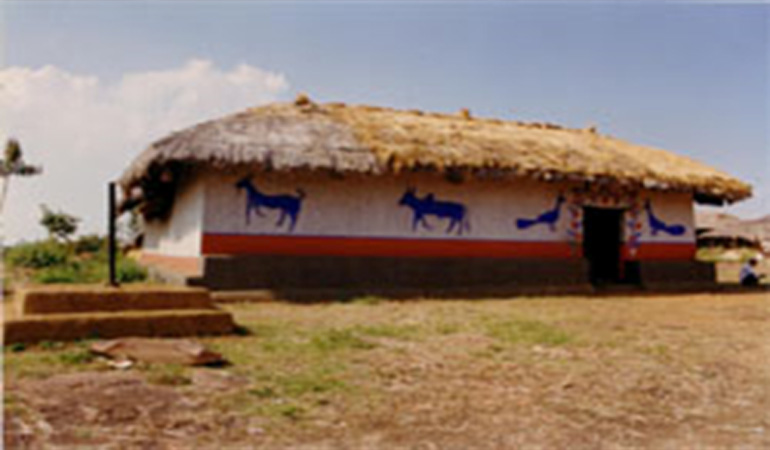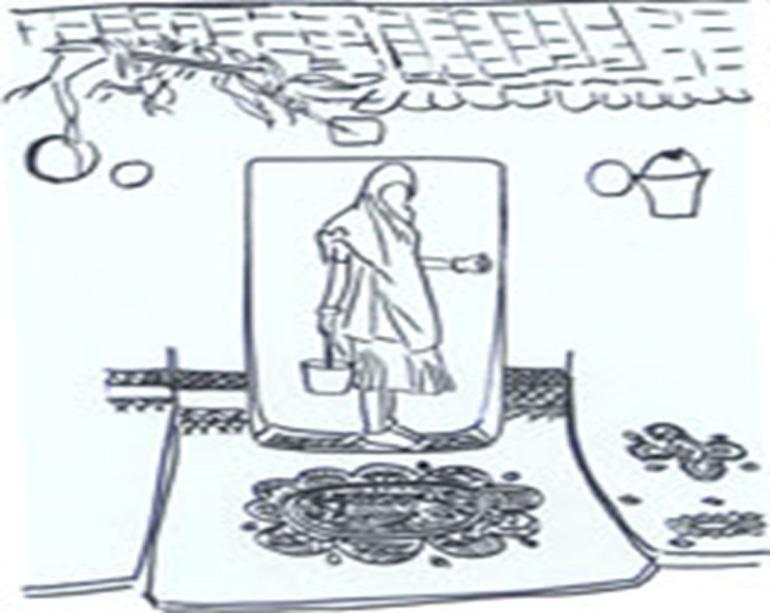Introduction
Home art is a decorative forms of painting on mud walls of their huts or craft done by common village folk in an attempt to beautify themselves and their surroundings. It is also an effort to give an aesthetic look to their house. The art forms, that may take the form of human figures, animals, flowers, decorative designs, are associated with religion. Such forms are painted on auspicious occasions and therefore they do not die, they survive.
Home art is a vast subject and includes in its gamut all kinds of floor decorations (variously known as chowk, alpana, mandala, rangoli etc.) and bitti chitra. , The genesis of these paintings lies in ‘protection’. Those who decorate their walls with bithi chitra are trying to secure their houses from evil spirits. The wish for plentiful supply of food, being blessed with progeny is also expressed in symbols. The artist, directed by individual talent under the influence of surrounding culture, creates a variety of patterns and forms. This has led to the evolution of abstract designs and multiplicity in the fabrication of human form.
In several parts of India, especially among the adivasis and Hindus in rural areas women artists produced a type of home art whose boundaries are within the house. Mud floors and mud wall are suitable canvas for such arts. The focal point is kohbar ghar– the inner room of the house where the god is installed. Though each and every home in India is the place where we can see this type of art, Madhubani painting from Mithila, Bihar, Warli paintings from Maharashtra are the perfect example of this art. They religiously paint and draw designs on walls and floors of their houses on various occasions.
Floor designs called Alpana are found in almost all the states of northern India in various auspicious occasions and festivals.. In Tamilnadu and Andra Pradesh women draw rangoli or designs with symbolic diagrams on floor near the entrance to their homes every morning throughout the year, whereas during Pongal and other festivals they create special designs with large, complex structure and intricate linear details. The diagrams, forms and symbols used in such designs are merely decorative. Instead, they are believed to generate the magical protective and propitious energy of tantric mandalas that have their roots in primitive consciousness and Vedic culture. Some diagrams have forms and symbols that have not changed during the last two thousand years or more.
Volumes can be written on each of these varieties of village folk paintings. In this chapter two types of folk art have been taken for study.
Jump To Section
Bhitti Chitra

Bhitti chitra or mud wall painting is an outlet through which decorative forms were employed by common village folk. It is an attempt to beautify the surroundings auspicious folk motifs, giving an aesthetic meaning to otherwise drab, bare walls. The ground is never left blank. The art forms are associated with religion and auspicious occasions. They adorn clay walls with puranic gods and ornamental forms of birds, serpents, flowers and geometrical designs on festive occasions. The deity always occupy a central place with floral and animal forms that provided an appropriate decorative design. At some places and on some occasions, only geometric arrangements as motif were used. The paint is prepared by mixing rati (colour made of red earth) and khadia (white chalk) in water. A cement plastered wall of today is not a good canvas for this art.
Bhumi Chitra
Bhum chitra or Alpana design is a form of traditional art. It is composed mostly by women to beautify wall and floor of huts. A decorative alpana is drawn at the entrance of a house, courtyard in temples and before the deity in the house. The material used is usually a paste of powdered rice, sometimes mixed with crushed turmeric or some local material such as chalk and geru or red colour, stone colours, sea shells to give it attractive colours. It is believed that an alpana has a miraculous effect of invoking protection from the great powers. Ritualistic alpana designs are mostly symbolic and composed of motifs. They can be seen on festive occasions which come throughout the year. Clay wall of a village hut provides a suitable canvas for such decorations. Vedic gods, sun, moon and navagraha(nine planets) birds, animals, flowers, ornamental forms and some geometrical designs are common motifs in alpana. Though the motifs are stylized the overall alpana with bright colours emerges as a beautiful piece of village art. Some alpanas are integral to great festivals and are common for the whole country while some are particular to a region.

Kashidakari

The origin of this art can be traced to beyond age. The discovery of bronze needles at the site of Mohenjodaro (2500-1700BC) proved that there was a knowledge of needle craft even so long age. In Buddhist period (500BC-600AD) there are innumerable examples of embroidered motifs on the costumes of the sculptured figures are found. In Ajanta paintings dresses of people are shown beautifully embroidered in many designs.
Today embroidery appears on garments and decorative items of all kinds and found throughout the country. The striking feature is that fundamental similarity not only in craftsmanship of stitch but in designs and colours.

